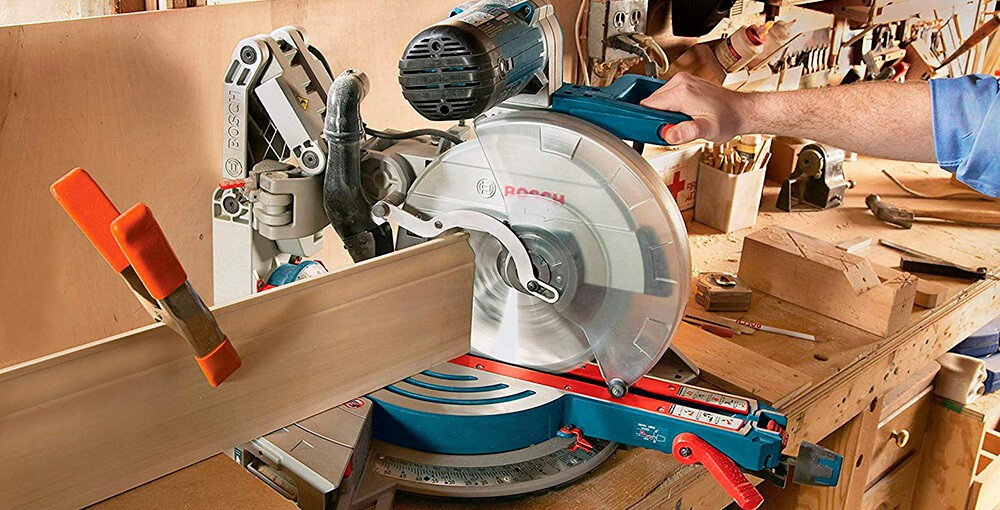
If working on construction sites or in furniture-making workshops, it’s crucial to use the best miter saw to ensure easy and accurate сutting, as well as comfortable use. The following reviews help choose the appropriate models for sawcutting of softwoods and hardwoods, plastic, wood-fiber boards, laminate, or aluminum profiles. One can pick the model either for DIY or industrial projects.
The miter saw reviews below allow choosing a tool with a powerful enough motor to provide optimum performance, sound pressure, and circular saw blade rotation speed.
The product’s descriptions include compound, slide, and dual models of different dimensions and weights with powerful engines that are able to provide fast cutting. One can make a note of the units with blades of various diameters that determine the width and depth of the kerf mark. Bear in mind that each model has its own inclination and rotation angles, as well as extras in addition to basic options.
Miter Saw Reviews
Dewalt DWS780 — Best sliding compound miter saw
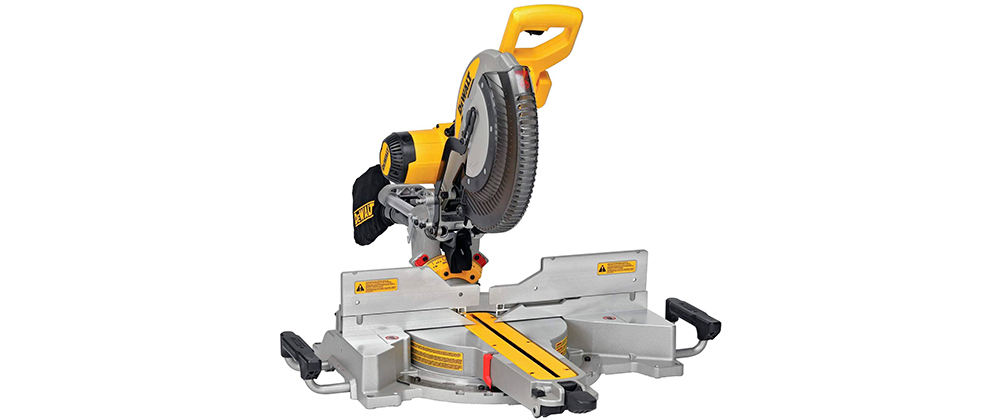
If requiring the best sliding miter saw, give attention to this model as it features a powerful motor. The saw is designed for making horizontal and vertical angled cuts and for cutting elaborate angles (in crown moldings, for example) due to its double bevel. Besides, it’s possible to regulate the miter detent plate (more than 10 stops) to ensure the highest accuracy of the operation and to make the unit 100% suitable for professionals.
The motor works well with a brief soft start. The DWS780 runs smoothly and quietly but the saw is so powerful that when dropping the blade down to the cut and hitting the trigger, its arm jumps down into the wood before the user is ready. That’s why it’s necessary to make sure that the trigger is pulled well above the workpiece before bringing it down for the cut.
The dual bevel sliding compound miter saw features 16-inch cut depth. The dust collection tube terminates just beyond the end of the rails and when connected to the dust bag or a dust collection system adds several inches to what is already a very large depth requirement for the workbench or work area. Generally, a 36-inch deep workbench is necessary. To solve the issue, just add extra wood to the top of the workbench to accommodate the extra depth.
Pros
- The cutting LED light provides the shadow line that lights up the cut area and shows where the blade will cut.
- It copes with thick materials.
- This model comes with a blade wrench.
Cons
- The slide is a bit sticky and that’s not good for its frequent use.
Video Dewalt DWS780
Dewalt DWS715 — Best compound miter saw
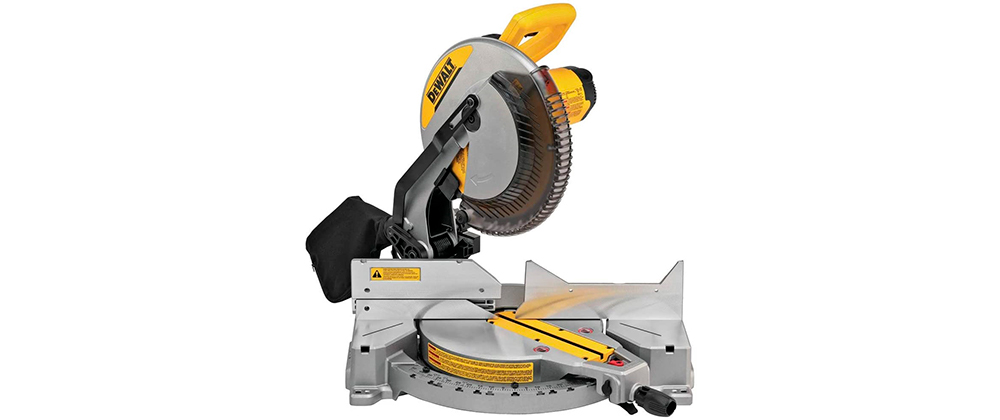
This model can be considered as the best compound miter saw for a bunch of reasons. Firstly, it has a powerful 15A motor that runs at a speed of 4000 RPM. Secondly, the saw features a carbide blade and a stainless steel housing, so its solid construction can definitely withstand some tough treatment.
This model is an upgraded version of the DWS779. The reviewed device is more expensive compared to its previous version. It also has a smaller number of teeth (32 vs 60), which means that it’s capable of dealing with tougher materials. In fact, it can cut up to 14-inch thick material.
The saw is equipped with an easy-to-read scale and has 14 stops allowing for great cutting accuracy. You can adjust the bevel angle left (up to 45°) and right (up to 3°). With a large 12-inch blade, the saw is a bit heavy (42.8 pounds).
Maybe, the DWS715 won’t be the best sliding compound miter saw in case a cheap appliance is needed, but the price is fair as for what this model can offer.
Pros
- There is a convenient side handle that makes it easier to control the saw while cutting.
- Surprisingly, the saw runs quietly, and I didn’t even feel the need to wear the ear protection.
Cons
- It doesn’t feature a laser, so if you aren’t an experienced carpenter, cutting straight may be difficult for you.
- The dust bag that comes with the unit is very thin and collects only half of the dust particles.
Video Dewalt DWS715
Bosch GCM12SD
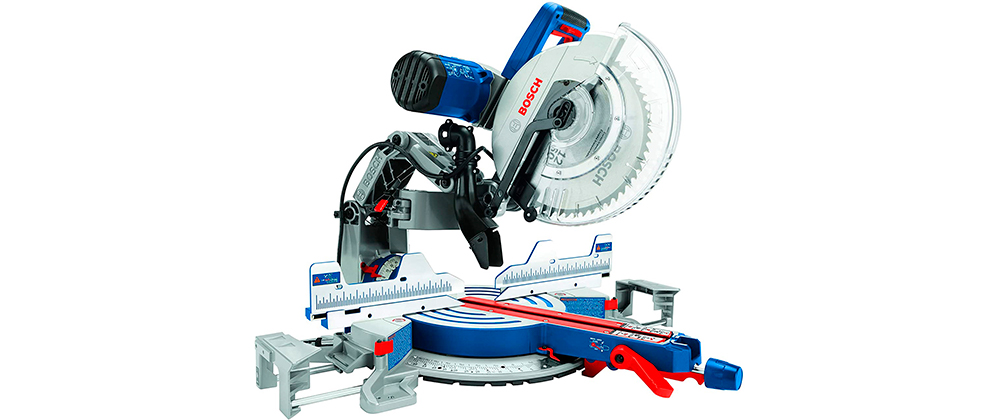
This double bevel miter saw is a really heavy-duty machine and fits even the high-end custom cabinet shops. The unit can handle any work with the right blade. The model features the Axial Glide mechanism, which allows mounting the tool up against a wall, and still retaining its 14-inch horizontal cut capacity. It makes it possible to do a lot of design work with the linear and other types of bearings.
The sliding rails don’t get dirty in the bearings and that prevents the sliding action’s sticking. So, there’s no need to take it apart for cleaning, saving money on silicone lubricants. Besides, no rails sticking out the back of the saw are noticed. The Bosch miter saw has a depth stop for creating a dado. It cuts nicely and glides effortlessly and it doesn’t hang up when cutting dadoes.
The GCM12SD comes with a decent blade that is great for general operations (framing lumber work, for example). The unit is easy to set up since the majority of the adjustments use the same-size Allen wrench that comes with the saw.
Pros
- The unit’s detent system is made of tight plastic that excludes any slop in the detents and makes all the cuts completely accurate.
- No gear clash that allows the tool to work quieter.
- It’s easy to control all angles from the front.
Cons
- It doesn’t come with crown stops, but they are available as optional accessories.
- No soft start is designed. The motor does spin up slowly but not enough to keep the handle from jerking as the blade comes up to speed.
Video Bosch GCM12SD
Metabo HPT C10FCGS — Best budget miter saw
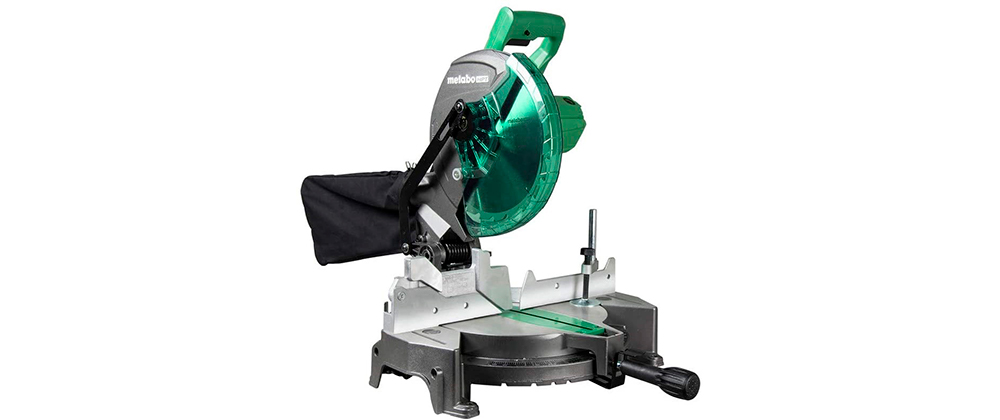
Searching for the best budget miter saw, you should definitely pay attention to this model from the Metabo manufacturer. This basic saw won’t be suitable for professional woodworkers, but it definitely can be used for numerous DIY projects (flooring, trimming, etc.).
This device features a 10-inch blade with 24 teeth that is easy to replace. The blade bevels up to 45°.
The design of this compound miter saw implies both simplicity and reliability. Thanks to the 15A motor, the saw appears to be powerful enough for cutting tough materials. The 5000 RPM speed allows making straight and clean cuts without hassle.
Weighing 24.5 pounds, it’s one of the corded miter saws on the market that you can easily carry around. Meanwhile, the model is equipped with a large table offering great workpiece support and a convenient handle to secure the operation.
The AC adapter that is included in the box is compatible with any Metabo HPT tool.
Pros
- The clamping system for supporting the material makes the tool operation safer.
- A dust collection port featured and a dust bag that comes in the package simplifies the working process.
- The price is reasonable—the tool’s price is under 200 dollars.
Cons
- The cord is too short (3.5ft).
- The saw is mostly made of cheap materials.
Video Metabo HPT C10FCGS
Dewalt DCS361B
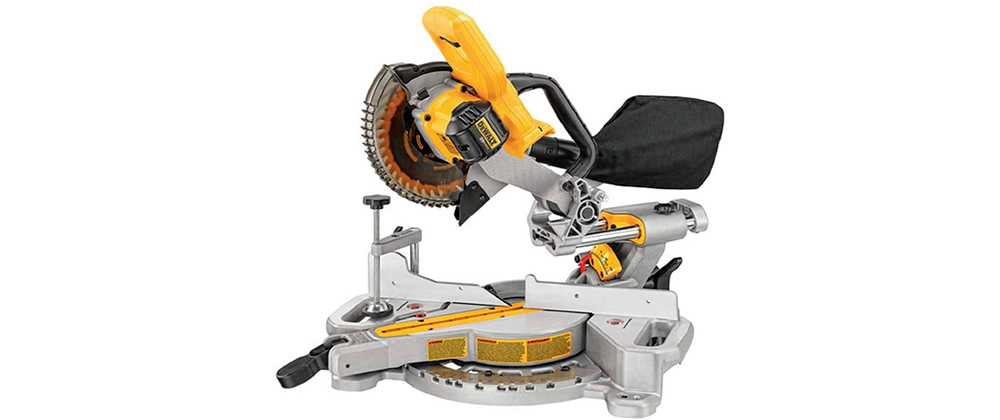
Given the fact that DeWalt is one of the most expensive brands, this model has drawn my attention due to the affordable cost. So, my question was does it provide the best value, as well as similar products from the manufacturer?
The DCS361B is a cordless model that uses a standard 20V battery. Being a lightweight (30 pounds) and portable device, it can be used during the ladder or ceiling works. The saw cuts very smoothly, and you don’t have to put an excessive effort when working with it. I also liked the fact that it comes fully assembled out of the box.
The DEWALT miter saw has a 7.25-inch blade, so don’t expect high capacity from it: this model is designed for cutting small trim. Nevertheless, it allows doing thinner cuts than other saws with large blades. The sharp blade enables you to cut precisely and evenly. Spinning at a speed of 4000 RPM max, the device is made of metal with a carbide finish that contributes to a lower vibration level. You can bevel the saw from -3° to 48° and use 11 preset stops to improve the cutting accuracy. The crosscutting can be performed to 8 inches max.
This cordless miter saw also features an LED light, switching off automatically when the saw is not in use to illuminate your working space. However, the momentary switch seems to be very small, and thus hard to press.
Pros
- A large bevel scale helps make the adjustments simply and accurately.
- The dust bag allows keeping your workplace neat.
- The tool works quietly.
Cons
- Although the blade is removable, replacing it is a time-consuming process.
Video Dewalt DCS361B
Dewalt DWS716XPS
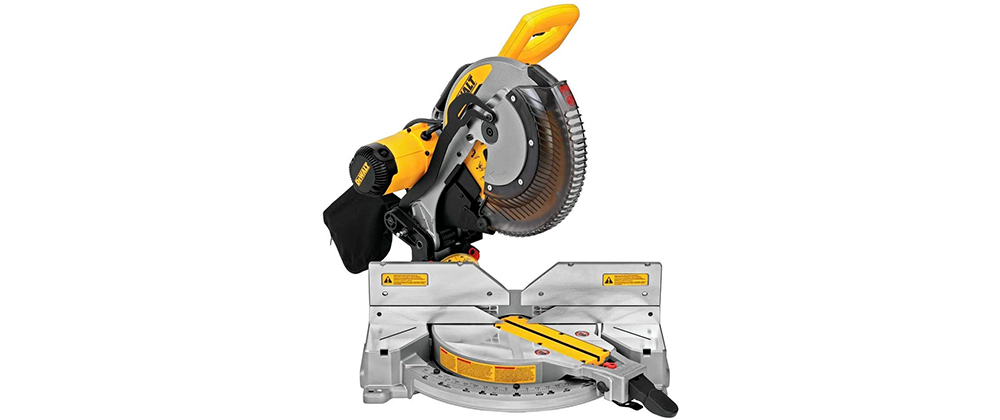
This DEWALT compound miter saw comes with a 12-inch blade that can be used for both tough carpentry and precision works. Its 15A motor and 3800 RPM of speed provide enough power for cutting thick and rough materials, while its adjustment system allows for accurate angles.
Out of the box, the saw makes an impression because of its durable construction. The all-metal bed and carbide blade are of top-rated quality. However, it’s one of the heaviest devices of our review: weighing 49 pounds, it isn’t about the portability.
Despite its weight, the saw was easy to assemble; I didn’t make extra effort putting the saw on the base. The LED light is on board to allow clearly seeing the cuts during the operation.
This compound miter saw also comes with a clamp. However, the clamp seems to be weak and cheaply made, which is strange considering the fact that the DWS716XPS is among the pricey models.
Pros
- The electric brake works exceptionally well and fast, so you can rely on this saw executing serious jobs.
- The safety switch doesn’t allow turning on the device until you depress it.
- Tall sliding fences contribute to the improved cutting process and provide better support.
Cons
- This saw is noisy, so think of ear protection, especially during the continuous cutting sessions.
Video Dewalt DWS716XPS
Hitachi C10FCG — Best 10 inch miter saw
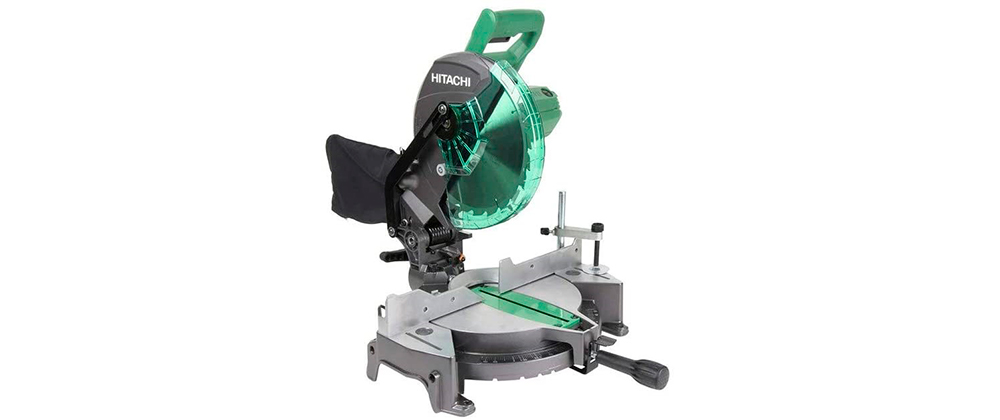
When thinking of the best miter saw, take into consideration this model as it features the best-rated construction and has no wiggles or vibrations during the work. The cuts are consistent and it’s possible to go through 4×4 treated lumber with no power issues. The instrument has a guard to protect hands very well—the brake slows the blade to a stop as the handle is raised.
The unit’s cutting table rises 3.5 inches above the surface on which the tool is mounted to the saw’s table surface. The thumb indexing for the preset stops is easy and intuitive. It’s made of spring steel that is more resistant to breakage than the plastic versions. For off-index angles, the large table handle is threaded to press the indexing spring against the table to hold the unit in its position. The angle tightening handle can be unscrewed enough to be removed.
A “T” and hex wrenches are assigned to a rubber holder to the top of the Hitachi miter saw for replacing the blade and making easy adjustments.
Pros
- The unit includes a material cage extender, a material clamp, and a base stabilizer bar.
- The tool works with aluminum flawlessly. It makes smooth, straight, and fast passes.
Cons
- It doesn’t slide and the blade travels only up and down.
- Since this is one of the manual miter saws, a stand isn’t included in the package.
Buyers Guide
Miter Saw — Basic Points One Should Know
This tool was invented to provide the highest attainable accuracy when cutting wood, plastic, and metal. Such saws consist of the reduction gear, motor, blade, and bed. The miter saw is attached to a workbench and it works on boards with a crosscut or angled cuts. So, unlike the handheld circular saw, it’s a stationary instrument.
The types of cuts that are possible to make depend on the blade. There are specific blades that are designed for certain materials. However, if it’s required to work with wide and long pieces of wood, it’s not just about a blade. In this case, it’s better to acquire the sliding compound miter saw.
How to Use a Miter Saw?
Even the best miter saw for beginners should be operated with extra safety. Before making cuts, consider some safety tips. First, any time the tool is used, it’s crucial to wear eye and ear protection. Secondly, secure loose clothing, jewelry, or long hair. Third, keep your eyes 6 inches from the blade. Then, it’s crucial to keep arms straight when cutting. The last thing to remember: support the workpiece with a stand.
Let’s get to the point.
- Before powering the tool up, bring the blade down and check it to make sure it’s on the mark.
- Then, bring the blade back up to the top position.
- Power up the assembly and bring it down into the material.
- Let the blade come up to the complete stop before the razor will back up again.
There are four basic cuts that one user should know to handle various projects: crosscut (straight cut), miter cut (it’s angled across the width of the board), bevel cut (it’s also angled but this time the angle goes to the thickness of the board), and a compound cut that combines the angled and bevel cuts.
There are also some basic adjustments to ensure high-quality work. To set a miter angle, it’s necessary to use the knob and lever in front of the unit and choose the right angle on the scale. To adjust the bevel angle, use the star-shaped knob on the back of the tool.
How to Cope with Crown Molding with a Miter Saw?
As the crown molding (ceiling molding) means using corner joints to fix it between the ceiling and the walls. Each board has a miter cut from one side and a bevel one from another. Since it demands angled cuts in two planes, the compound miter saws will come in handy. How to make the joints fit perfectly to each other? Some techniques exist but first, let’s consider the most traditional (compound) method:
- Take the right-side board.
- Place the top of the molding against the fence.
- Set the bevel to 33.85.
- Set the miter to the right at 31.62
- Make the cut.
Is it possible to make crown molding without bevel cutting? If a unit features a tall fence, crown molding can be done in a nested position against the fence meaning no beveling at all. In this case, one of the crown mold surfaces is on the saw’s table and another one is up against the saw’s fence that allows keeping the board fixed in its place and getting a more accurate cut, as a result.
Miter Saw’s Scope of Application
Woodworking and metalworking are the main industries where this equipment is in demand. It’s developed to cut boards fast and get ready-to-use details with accurate, clean cuts, and correct angles. The tool is able to make common crosscuts, angles, bevel, and compound angles, as well as repeatable cuts. To put it simply, the instrument is indispensable for making miter and all the types of angled and orthogonal cuts in the range of 45–90 degrees
This equipment does its job when it comes to delicate small-scale woodworking operations and fine-cutting projects.
How to Replace the Blade on a Miter Saw
Very often, it’s necessary to replace the blades with other blade types since this machine’s part change makes all the difference and transforms the tool.
- Start by pointing the blade guard away from you.
- Loosen the screw that secures the blade guard mounting hardware.
- Pull the hardware back.
- Now, there’s access to the mounting screw.
- Press the blade-locking pin and rotate the blade until the pin falls into its detent.
- Turn the mounting bolt in a clockwise rotation and remove it away from the saw together with the flange.
- Remove the blade.
Now, it’s time to install another blade and repeat all the actions in reverse order. Mount the blade back onto the saw and reinstall the blade flange and the bolt. Then tighten the bolt with the wrench. The last thing to do is to install the guard hardware back and tighten the screws with the screwdriver.

